How to Create Windows 7 Recovery USB & Download Source
Second Method: From a Windows 7 computer without an optical drive.
1. Download and install TotalMounter. This program creates a virtual CD/DVD drive which can actually be written to, unlike programs like Daemon Tools which are read only. Administrator privileges are required to use this program.
2. Run TotalMounter from the Start Menu (All Programs -> KernSafe -> TotalMounter -> TotalMounter) to bring up the main interface. Click Mount -> Virtual CD/DVD-RW.
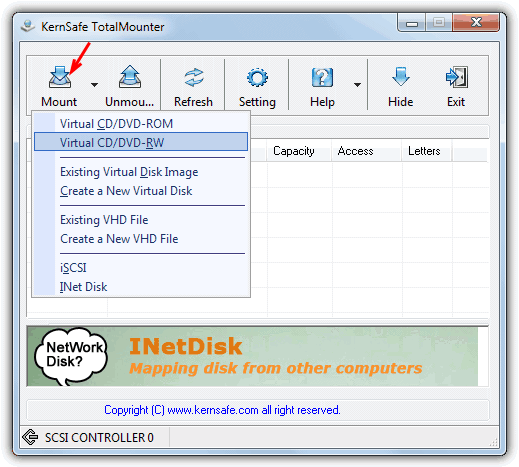
3. In the next window, click the Browse button to select a location and file name for the ISO you will create. Leave Create Type and Disc Type alone, then click OK. A new device will appear in the TotalMounter main window, make a note of the letter the drive has been given.
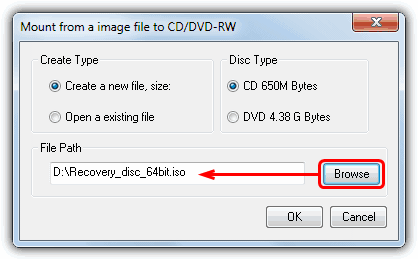
4. Run the Windows system repair disc creator by going to Start and typing recdisc into the search box. Once loaded, select the drive letter you noted from step 3 and click Create Disc.
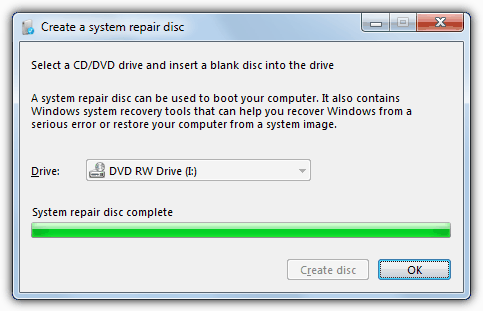
5. Go back to the TotalMounter window, right click on the drive in the window to select it, then click Unmount. An ISO will now be created at the location and with the name you gave in step 3.
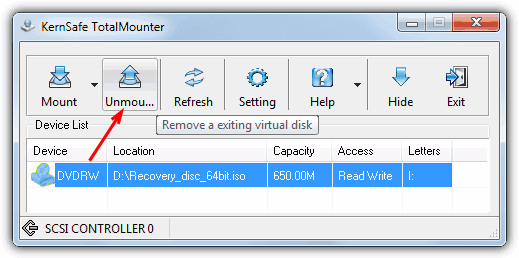
The 32-bit recovery ISO will be around 143MB and the 64-bit will be around 165MB. TotalMounter can be uninstalled if you don’t want it anymore.
Step Two: Writing the ISO to USB
1. If you never used the first method from above, download and install the trial version of PowerISO.
2. Start PowerISO and then go to the Tools menu -> “Create Bootable USB Drive”. Administrator privileges are required for this function and the program will restart if it needs to elevate itself.
3. In the Create Bootable USB Drive window, all you have to do is click the button and find your ISO image you made from step one, make sure the Destination USB drive is correct, and then click Start.
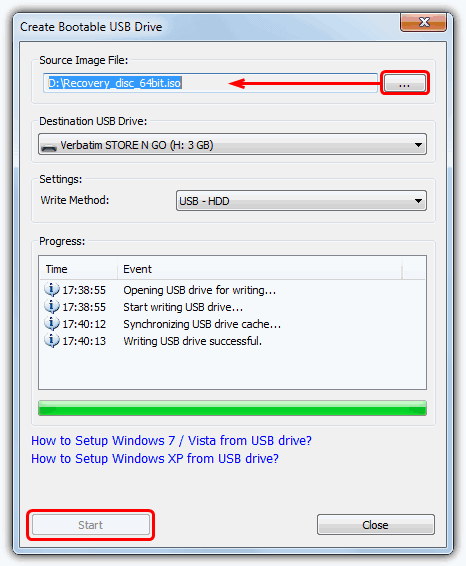
After the process has finished, the USB stick is ready to be booted from.
As with step one, UltraISO can be used instead of PowerISO if you prefer, Here’s the create USB instructions for it:
1a. Download and install the Trial of UltraISO if you haven’t already.
2a. Start UltraISO , then go to File -> Open or press Ctrl+O and open the recovery ISO image you have previously created. Once loaded, go to the Bootable menu -> “Write Disk Image”
3a. All that’s required here is to make sure the correct USB drive is selected and then click the Write button. No other settings need changing.
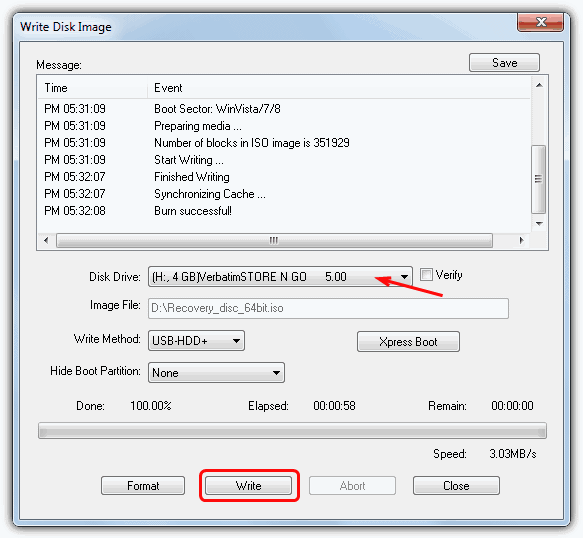
Remember that these repair and recovery discs made through Windows 7 are architecture specific. A recovery disc made from a 32-bit Windows will only work on 32-bit, and 64-bit will only work on 64-bit etc.

When I switch on my netbook it says “windows failed to start a recent hardware or software change might be the cause”
Thanks for sharing this information on windows 7 recovery disk
That article is nice but it doesn’t clarify why Recovery Tools fails such as “Windows cannot check for memory problems” from Windows Memory Diagnostic Tool. I have created a Windows 7 installation DVD from official iso and running Windows Memory Diagnostic from this DVD shows error that it cannot check. My current OS is not Windows 7 but Xp. What is the reason of this failure?
The problem you are having is different from the problems listed here. Windows 7 install/recovery simply doesn’t handle booting or installing from USB too well, which is why these listed errors crop up.
Method 2 (TotalMounter)
D is a real hard disk. I-virtual laser. Question: in window 3 D written correctly in the path? Or in window 3 it is necessary to write a laser disk I?
Tanks
Hi All, Good tutorial, but this is how i will manage with a limited no. of pen drives 1. i would make two multiboot pen drives with several windows installation isos & utilities on them : one with YUMI ( BIOS ) & the other one with SARDU ( UEFI ). 2. For repairing/troubleshooting purposes, i would use these multiboot pen drives but, for installation purposes, i would always make temporary RUFUS pendrive .3. When required, i will use multiboot pendrives to boot into the particular windows installation media & make the use of ”repair my computer” as system repair disc. 4. i would use ImageUSB by Passmark to backup & restore various pendrive images. 5. & All of that is very well mentioned/discussed/described on this great platform RAYMOND CC ! Thanks & Regards.
1. Excellent tutorial!
2. Easy2Boot (E2B) is an excellent alternative to PowerISO and UltraISO; I recommend that you ad it to your tutorial.
Method 2 worked for me. Thanks a lot!
Just wondering if I can still use the usb to store other files in it? Thanks again.
Thank you so much this information helped me a lot Big Thanks
Great information… seeing how all the recovery iso files for win7 are 600mb, and the trial version of the iso programs only support 300.
get that money.
I really don’t know where you get the idea that the repair disk ISO from Windows 7 is 600MB but it is totally wrong.
The Windows 7 32-bit ISO is 143MB, the 64-bit ISO is 166MB, it even tells you in the article the size of the ISOs if you read. Each easily fits within the 300MB limit imposed by the trial versions of the software used in the article, no need to pay a dime for anything.
i am also facing the same problem as srikant is facing i have 3 recovery dvds and as u sugested above yumi is not working for me can u help me out each and every dvd contain a data.bin file with same name as data.bin i am have a hp notebook pavilion dv4 3016tx
how do i fix my computer with boot mgr compress or missig with a usb flash drive
Thank you so much this informtion helped me a lot!!!!!!!!!!!!!!!!!!!!! Big Thanks
Very slick! Thank you!
Thanks :)
I have a bootable usb rescue disc. Unfortunately when I select restore from image, I get an error message as follows:
To restore this computer, Windows needs to format the drive that the Windows Recovery Environment is currently running on. To continue with the restore, shut down this computer and boot it from a Windows Installation disc or a system repair disc and then tyr the restore again.
This doesn’t make sense as the drive where windows will be restored is blank. The only way I found to restore was to actually create the system rescue disc and boot from the dvd drive.
Frustrating experience I thought the CD/DVD went away but I suppose windows 7 is the last technology dependant on that era. The DVD is dead, long live the DVD.
What should I do if I have multiple recovery dvd’s .I mean how to copy all into a pendrive
Something like YUMI might be able to do that for you.
https://www.raymond.cc/blog/how-to-install-windows-7-faster-using-usb-flash-drive/2/
Thanks a lot for your tutorial..
I was’nt able to create a w7 rescue disk on my dvd writer. Driver problem maybe ? But I still can burn iso using other software ( BurnCDCC for example) .
microsoft advice was to replace my dvd writer. Very kind to them…
Extremely helpful information, especially the total mounter utility. I wasted days trying to solve recovery disk issue (drive not ready error / parameter incorrect). Thanks ton!
Most any USB drive method will work for Win 7 as long as you remove the USB flash drive just before the reimaging process starts. Let it find the image and click next. Then remove the flash drive. Once it is restored it will reboot. I downloaded a Win 7 iso from Digital River and used the Microsoft Windows 7 DVD Tool to make mine, but I tried many methods from tutorials and most work if you unplug them as I’ve described. Any repair disk on a DVD will work as a source for needed files as well (You just need to get a decent tutorial onlie for making the USB bootable.
The instructions worked fine, but now my pen drive isn’t accessible – it gives an error saying it’s corrupted and unreadable. Is that expected?
No, that’s not normal, something has gone badly wrong during the process as the pen drive should be readable. Try from the beginning again…
The USB flash drive needs to be clean?
It doesn’t have to be clean as any data currently on the flash drive will be overwritten. Doesn’t hurt to format the drive first yourself though.
Great work! Thanks a lot. After a long time trial and error I found your tutorial that works on creating a bootable USB-stick containing W7 rescue DVD.
Thanks so much for this guide! It saved my system today when I had a partitioning disaster.
Thankfully, I found your site and followed your instructions to create a Windows 7 system recovery usb before I attempted partitioning my netbook’s hard drive.
This needs to be a bookmark for all Windows 7 users everywhere. 2 years one, and still incredibly relevant. Many thanks to you, man; using Method 2, I got myself a repair disk without having to get a CD burner.
Many thanks. Method 2 worked for me. You’re a genius (compared to me). Why don’t Microsoft provide basic support information to their users?
great article.. it helped me a lot..
thank you very much
Hi. Great article and it worked fine.
Thanks for the instructions.
Thanks for the info. You saved the day.
This is good!
Thanks for the tip! The flash drive seems to boot up.
thanks buddy…
every time i use software for creating pendrive bootable.
this information is helpful.
thanks again
Thanks buddy!
Nice One Ray, good clear instructions :)
Thanks Raymond. Nice info ;).
this one is much better than the cd.
thanks for the tutorial.
Nice info. Keep it up.
Wow…nice and very useful as always…thanks
A good tip,especially if you have a netbook.